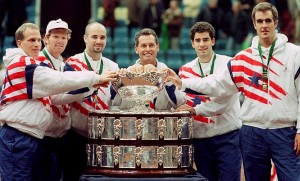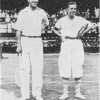By Randy Walker
@TennisPublisher
Boris Becker once had a famous description of Davis Cup.
“It takes a week to prepare, a week to play and week to get over.”
Davis Cup, the most historic international team competition in all of sport, is a different kind of competition than your every day tour event. That’s why it is so special. Playing for your country can inspire players to achieve great feats, or be such an enormous burden that it causes a player to fail in spectacular fashion.
If you ask any man who played professional tennis, who did not win a major tournament but did play Davis Cup for their country, I bet 99 out of 100 of them would likely say their career highlight was playing Davis Cup.
So then, if you are top ATP-ranked player, like Novak Djokovic, Andy Murray, Roger Federer, Rafael Nadal or others, you especially need that week to prepare for Davis Cup – and the week to get over the Davis Cup. So when the dates of the competition are scheduled the week after the Australian Open and the Miami Open (coming right after Indian Wells as the second two straight important Masters 1000 events regarded as the top two non-Grand Slam events), it’s no wonder the top players are skipping the competition. They need the break! They need to exhale after putting so much into winning these major and important individual events. To boot, the week after the Australian Open is traditionally when the Super Bowl is played in the United States, which sucks away media and fan attention from the Davis Cup in a good part of the world. The week after the Miami Open is when the Masters is played in Augusta National, another way for the Davis Cup to get ripped off the front pages of sports sections. Most sports fans focus on Masters golf than Davis Cup tennis.
In past years, depending on the schedule of Davis Cup, the event was held the week after Wimbledon and the U.S. Open. For top players, this is foolish and irrational. There is nothing more challenging and exhausting than a top player grinding for two weeks at a Grand Slam tournament, in best-of-five set matches, under incredible fan, sponsor and media scrutiny, under tremendous pressure to perform, to immediately turn around the next week – without the “week to prepare” as Becker eloquently stated – and travel to a Davis Cup site, sometimes on the complete other side of the planet, on a completely different court surface.
As the event is structured now, the ideal time for the first week of the competition is the first week of March – before the Indian Wells-Miami double and a good month after the Australian Open. Since Indian Wells is a 10-day event, with top players getting a bye in the first round to rest (take note of that as well), then the top players will have that “week to get over” Davis Cup and will allow players to travel from great distances to their next destination (Indian Wells) with plenty of recovery time. Late February and March is generally a “dead” period in the sports calendar with not many major events to compete against, so fans and media attention would be more focused on Davis Cup.
Under the current Davis Cup format, the next ideal Davis Cup date for the quarterfinal round would be two weeks after Wimbledon, as it has been in the past. This would give top players a week to recover from a deep run into Wimbledon and give them time to recover and rest while also being their “week to prepare” for Davis Cup. This can be a bit of a challenge in the tournament calendar as Wimbledon is now one week later in July and the summer hard court season is jam-packed, not to mention years when the Olympic Games are played. For the top players, they generally only play Canada and Cincinnati anyway, which are not played until August, so this is the best that can be done. These July dates are also relatively light as far as competition from other major sports events, depending on the Open Championship golf dates and also World Cup and European Championship soccer. Fan and media interest in Davis Cup would be higher.
The Davis Cup semifinal round, in the current format, is held the week after the U.S. Open, which is again, insanity, as players, fans and media – not to mention tennis officials and staff – are burned out after the rugged summer season of tennis. A decade ago when I served as the U.S. Davis Cup team’s press officer, the Davis Cup was held two weeks after the U.S. Open, which still might not be enough time to prepare for, but certainly better than the week after. Three weeks after the U.S. Open, perhaps leading into early October, would be ideal. There has been talk about the Davis Cup semifinal and final rounds being played in a neutral location over two weeks, which could be an option for this date, or in the final week of the season in early December, the traditional date of the Davis Cup final.
The Davis Cup is one of the most special competitions in the sport of tennis. It deserves more respect in its scheduling for it – and the sport of tennis – to continue to grow and gain popularity.


